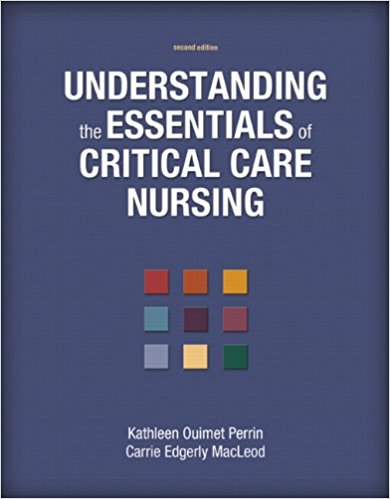Understanding the Essentials of Critical Care Nursing 2nd Edition BY Kathleen – Test Bank
Original price was: $55.00.$19.00Current price is: $19.00.
Digital item No Waiting Time Instant Download
ISBN-10: 0134146344, ISBN-13: 9780134146348
Publisher : Pearson;
Author Kathleen Ouimet Perrin Carrie Edgerly MacLeod
Description
Understanding the Essentials of Critical Care Nursing 2nd Edition BY Kathleen – Test Bank
Understanding the Essentials of Critical Care Nursing 2nd Edition BY Kathleen – Test Bank
Chapter 1 What Is Critical Care?
1) Identify who of the following patients suffers from critical illness. A patient:
1. With chronic airflow limitation whose VS are: BP 110/72, P 110, R 16.
2. With acute bronchospasm and whose VS are: BP 100/60, P 124, R 32.
3. Who was involved in a motor vehicle accident whose VS are: BP 124/74, P 74, R 18.
4. On chronic dialysis with no urine output and whose VS are: BP 98/50, P 108, R 12.
Answer: 2
Explanation:
1. Acute bronchospasm can present a life-threatening situation, which can jeopardize a patientʹs
survival. #1, #3, and #4 are examples of non-life-threatening situations.
Nursing Process: Assessment
Cognitive Level: Analysis
Category of Need: Physiological Integrity–Physiological Adaptation
2. Acute bronchospasm can present a life-threatening situation, which can jeopardize a patientʹs
survival. #1, #3, and #4 are examples of non-life-threatening situations.
Nursing Process: Assessment
Cognitive Level: Analysis
Category of Need: Physiological Integrity–Physiological Adaptation
3. Acute bronchospasm can present a life-threatening situation, which can jeopardize a patientʹs
survival. #1, #3, and #4 are examples of non-life-threatening situations.
Nursing Process: Assessment
Cognitive Level: Analysis
Category of Need: Physiological Integrity–Physiological Adaptation
4. Acute bronchospasm can present a life-threatening situation, which can jeopardize a patientʹs
survival. #1, #3, and #4 are examples of non-life-threatening situations.
Nursing Process: Assessment
Cognitive Level: Analysis
Category of Need: Physiological Integrity–Physiological Adaptation
Learning Outcome: 1-1: Define critical care
Understanding the Ess. of Critical Care Nursing (Perrin) — CVC 12/3/08 — Page 1
2) Of the following patients, who should be cared for in a critical care unit? A patient: (Select all that apply.)
1. With an acetaminophen overdose
2. Suffering from acute mental illness
3. With chronic renal failure
4. With acute decompensated heart failure
Answer: 1, 4
Explanation:





Be the first to review “Understanding the Essentials of Critical Care Nursing 2nd Edition BY Kathleen – Test Bank”